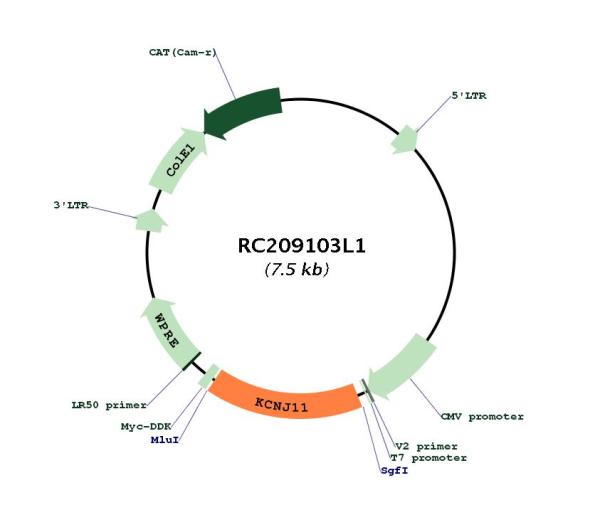Kir6.2 (KCNJ11) (NM_000525) Human Tagged Lenti ORF Clone
CAT#: RC209103L1
- LentiORF®
Lenti ORF clone of Human potassium inwardly-rectifying channel, subfamily J, member 11 (KCNJ11), transcript variant 1, Myc-DDK-tagged
"NM_000525" in other vectors (6)
Specifications
| Product Data | |
| Type | Human Tagged ORF Clone |
| Tag | Myc-DDK |
| Symbol | Kir6.2 |
| Synonyms | BIR; HHF2; IKATP; KIR6.2; MODY13; PHHI; PNDM2; TNDM3 |
| Vector | pLenti-C-Myc-DDK |
| E. coli Selection | Chloramphenicol (34 ug/mL) |
| Mammalian Cell Selection | None |
| Sequence Data |
The ORF insert of this clone is exactly the same as(RC209103).
|
| Restriction Sites |
SgfI-MluI
Cloning Scheme for this gene
Plasmid Map

|
| ACCN | NM_000525 |
| ORF Size | 1170 bp |
| OTI Disclaimer | The molecular sequence of this clone aligns with the gene accession number as a point of reference only. However, individual transcript sequences of the same gene can differ through naturally occurring variations (e.g. polymorphisms), each with its own valid existence. This clone is substantially in agreement with the reference, but a complete review of all prevailing variants is recommended prior to use. More info |
| OTI Annotation | This clone was engineered to express the complete ORF with an expression tag. Expression varies depending on the nature of the gene. |
| Product Components | The ORF clone is ion-exchange column purified and shipped in a 2D barcoded Matrix tube containing 10ug of transfection-ready, dried plasmid DNA (reconstitute with 100 ul of water). |
| Reconstitution | 1. Centrifuge at 5,000xg for 5min. 2. Carefully open the tube and add 100ul of sterile water to dissolve the DNA. 3. Close the tube and incubate for 10 minutes at room temperature. 4. Briefly vortex the tube and then do a quick spin (less than 5000xg) to concentrate the liquid at the bottom. 5. Store the suspended plasmid at -20°C. The DNA is stable for at least one year from date of shipping when stored at -20°C. |
| Reference Data | |
| RefSeq | NM_000525.3 |
| RefSeq Size | 3418 bp |
| RefSeq ORF | 1173 bp |
| Locus ID | 3767 |
| Cytogenetics | 11p15.1 |
| Protein Families | Druggable Genome, Ion Channels: Potassium, Transmembrane |
| Protein Pathways | Type II diabetes mellitus |
| MW | 43.5 kDa |
| Gene Summary | Potassium channels are present in most mammalian cells, where they participate in a wide range of physiologic responses. The protein encoded by this gene is an integral membrane protein and inward-rectifier type potassium channel. The encoded protein, which has a greater tendency to allow potassium to flow into a cell rather than out of a cell, is controlled by G-proteins and is found associated with the sulfonylurea receptor SUR. Mutations in this gene are a cause of familial persistent hyperinsulinemic hypoglycemia of infancy (PHHI), an autosomal recessive disorder characterized by unregulated insulin secretion. Defects in this gene may also contribute to autosomal dominant non-insulin-dependent diabetes mellitus type II (NIDDM), transient neonatal diabetes mellitus type 3 (TNDM3), and permanent neonatal diabetes mellitus (PNDM). Multiple alternatively spliced transcript variants that encode different protein isoforms have been described for this gene. [provided by RefSeq, Oct 2009] |
Documents
| Product Manuals |
| FAQs |
| SDS |
Resources
Other Versions
| SKU | Description | Size | Price |
|---|---|---|---|
| RC209103 | KCNJ11 (Myc-DDK-tagged)-Human potassium inwardly-rectifying channel, subfamily J, member 11 (KCNJ11), transcript variant 1 |
USD 457.00 |
|
| RC209103L2 | Lenti ORF clone of Human potassium inwardly-rectifying channel, subfamily J, member 11 (KCNJ11), transcript variant 1, mGFP tagged |
USD 757.00 |
|
| RC209103L3 | Lenti ORF clone of Human potassium inwardly-rectifying channel, subfamily J, member 11 (KCNJ11), transcript variant 1, Myc-DDK-tagged |
USD 757.00 |
|
| RC209103L4 | Lenti ORF clone of Human potassium inwardly-rectifying channel, subfamily J, member 11 (KCNJ11), transcript variant 1, mGFP tagged |
USD 757.00 |
|
| RG209103 | KCNJ11 (tGFP-tagged) - Human potassium inwardly-rectifying channel, subfamily J, member 11 (KCNJ11), transcript variant 1 |
USD 657.00 |
|
| SC321488 | KCNJ11 (untagged)-Human potassium inwardly-rectifying channel, subfamily J, member 11 (KCNJ11), transcript variant 1 |
USD 457.00 |
{0} Product Review(s)
Be the first one to submit a review






























































































































































































































































 Germany
Germany
 Japan
Japan
 United Kingdom
United Kingdom
 China
China



